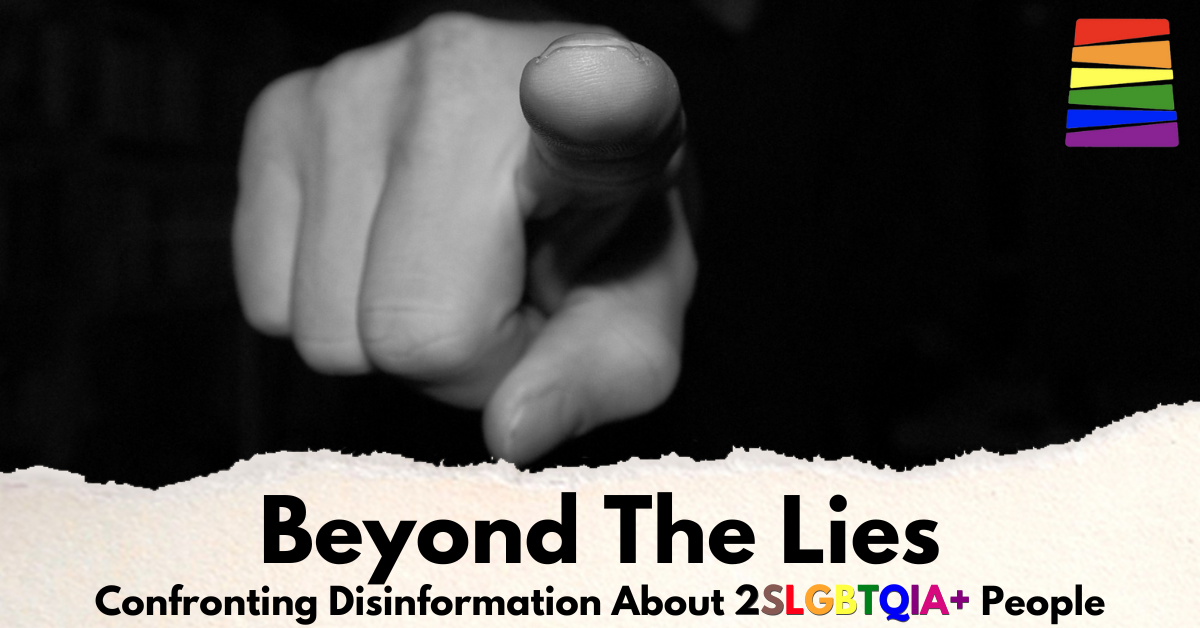Beyond The Lies
Beyond The Lies: Confronting Disinformation About 2SLGBTQIA+ People
by Jamie Arpin-Ricci

(Content Warning: The following article contains mention of bigotry & self-harm.)
One of the most common experiences I hear from 2SLGBTQIA+ folks (as well as many allies) is the hateful accusations that are levelled against our community through disinformation and misinformation. The most extreme and frequent ones tend to be those that call us “pedophiles” and “groomers”—a term implying that 2SLGBTQIA+ individuals (and their allies) are actively engaging in sexually predatory behaviour towards children. And while most reasonable people would recognize the wildly dangerous lie for what it is, far too many people do not.
This growing practice not only has serious consequences on a societal level, it also poses direct threats to 2SLGBTQIA+ individuals. On a cultural level, this calculated accusation perpetuates stigma which in turn heightens discrimination, further polarizing our communities in a time when we need to stand together for inclusive change. On a personal level, such accusations seriously impact the mental health of 2SLGBTQIA+ folks, leading to increased anxiety, depression, and risk of self-harm. Further, it makes it harder for us to thrive in education or employment contexts. Worse, it increases the risk of violence.
So where did all of this start? While we can’t go into too much detail here, let’s take a brief look at the history.
The History Of Disinformation
In the late 20th century, disinformation campaigns against 2SLGBTQIA+ movements drew heavily from early 20th-century homophobic conspiracies in Germany, particularly marked by the Eulenburg affair, which likened homosexuality to societal decay. This notion was echoed in post-World War I Germany where rising visibility of 2SLGBTQIA+ individuals sparked claims of homosexuality as a “social contagion.” Similar sentiments were institutionalized through laws like the USSR’s Article 121, conflating homosexuality with pedophilia, and persisted in various forms across the world.
In the United States, the post-war period mirrored this discrimination with states passing laws against “sexual psychopaths,” confusing homosexuality with pedophilia, further fueled by the Lavender Scare. The government’s inquiries and policies during this time, including the first Diagnostic and Statistical Manual of Mental Disorders in 1952, pathologized homosexuality, deepening societal stigma and paving the way for further discriminatory acts.
The 1970s saw Anita Bryant’s “Save Our Children” campaign significantly heighten these stereotypes. Bryant mobilized her public influence to repeal nondiscrimination ordinances, falsely portraying homosexuality as a threat to children’s safety. Her campaign not only fueled nationwide anti-2SLGBTQIA+ sentiment but also inspired similar legislative efforts like the Briggs Initiative in California, aiming to ban gay and lesbian teachers under the guise that they would negatively influence children.
While this just brushes the surface, this historical pattern of vilification has profoundly impacted societal perceptions of the 2SLGBTQIA+ community, perpetuating dangerous myths that continue to resonate. The legacy of these disinformation campaigns continues to impact the world today.
The Current State Of Affairs
In recent years, this pattern of demonizing 2SLGBTQIA+ people has adapted to our current cultural/political landscape while still playing on the dangerous tropes of previous disinformation. During the 2010s there was marked increasing in anti-2SLGBTQIA+ rhetoric, again citing the supposed risk to children. Many socially and politically influential figures leveraged the language of “groomer” to incite fear and hatred, bolstering the increasing efforts to effect policies against 2SLGBTQIA+ rights and freedoms. The growth of social media strongly assisted in the rapid and wide-ranging spread of dis/misinformation.
The controversial “Don’t Say Gay” law in Florida, entitled the Parental Rights in Education Act, exemplified how political groups used fear and misinformation to rally their base, relying on language and characterizations that were false. They explicitly claimed that those opposed to the law were supporting or even participating in active grooming behaviours simply for advocating for 2SLGBTQIA+ inclusive education. This tactic has been (and continues to be) mirrored around the US and abroad, with particular emphasis being placed on transgender and non-binary individuals. All of this echoes the historical patterns we explored earlier, mobilizing people into supporting policy and values that are proven to be very harmful to already vulnerable people.
Globally, the trend continues as some political factions and groups use anti-2SLGBTQIA+ rhetoric to consolidate power by appealing to traditional values, often casting themselves as protectors of the family unit against a purportedly corrupting influence. This strategy has been observed in various European and African nations where laws harshly penalizing 2SLGBTQIA+ people are popularly supported under the pretext of protecting societal morals and children. The conflation of 2SLGBTQIA+ identities with moral decay remains a potent tool for stoking public fear and securing political support, demonstrating how deeply entrenched and globally pervasive these patterns of disinformation have become. (It should also be noted how deeply connected the global patterns are to the influence of colonialism).
Why Does This Happen?
The spread of myths labeling 2SLGBTQIA+ individuals as threats to societal morals and child safety is deeply rooted in several psychological and social dynamics. For example, Xenophobia, or the fear of the unfamiliar, plays a critical role, as it often leads to negative perceptions of those who differ from societal norms, including sexual and gender minorities. This fear is compounded by a lack of understanding or disinformation about 2SLGBTQIA+ issues, which can cause people to accept false narratives more readily.
Religious conservatism also significantly influences these attitudes; many conservative religious groups promote so-called “traditional family values” and often perceive 2SLGBTQIA+ lifestyles as a threat to these values. For instance, studies like the one by Herek and McLemore (2013) demonstrate that individuals who adhere to a literal interpretation of religious texts are more likely to hold negative attitudes towards 2SLGBTQIA+ people, viewing them through a lens of moral condemnation. Other studies have shown that mental health and quality of life 2SLGBTQIA+ youth in religious contexts are markedly worse in non-affirming communities, whereas they most often thrive in full affirming religious contexts.
The role of media in amplifying these false narratives is complicated. Certain media outlets, particularly those with conservative ideological leanings, have been documented to disseminate and reinforce these myths. For example, a study by Stroud et al. (2014) in the “Journal of Communication” showed that exposure to biased news sources can significantly alter perceptions and increase the belief in misinformation. These outlets often falsely portray 2SLGBTQIA+ rights as in conflict with religious freedom or parental rights, framing the community as a danger to traditional societal structures. Additionally, the advent of social media has exponentially increased the speed and breadth with which misinformation can spread. Platforms like X (Twitter), Facebook, and YouTube can serve as echo chambers, where users encounter only similar viewpoints, reinforcing pre-existing biases and spreading disinformation more widely, as noted by Allcott and Gentzkow in their 2017 study on social media and fake news.
The impact of these dynamics is profound. Media might not only spreads misinformation but can also allow for the organization and mobilization of groups opposed to 2SLGBTQIA+ rights, often resulting in targeted harassment campaigns, public demonstrations, or political lobbying against 2SLGBTQIA+ inclusive policies. The rapid dissemination of false information through these channels creates a challenging environment for countering these narratives, requiring concerted efforts in media literacy education and proactive counter-messaging strategies to promote understanding and acceptance of 2SLGBTQIA+ individuals. Above all, such a trend emboldens violence against 2SLGBTQIA+ people, especially transgender women.
What Do We Do About It?
Education play a crucial role in countering disinformation about 2SLGBTQIA+ individuals by addressing misconceptions and fostering a culture of inclusivity and respect. That is why The Rainbow Well exists- because we know that only with the right information and understanding can people meaningfully engage the complexities around gender and sexuality. Each us as individuals, as well as communities (such as churches, organizations, etc.), must dedicate ourselves to becoming aware of both the truth about 2SLGBTQIA+ people but also the nature and origins of disinformation.
It should be noted, however, that for many people who espouse the disinformation, it is not done out of a reasonable conviction based on well-researched evidence. It is often an emotional response that embraces ideas that support their pre-existing bias. As a result, many will not be receptive to reasonable discourse or clear evidence. In such cases, it is often better to avoid endless debate, with a few exceptions (such as if your response serves to provide a better narrative for others hearing/seeing the argument). This can be discouraging, but it is better to invest our time and energy into supporting 2SLGBTQIA+ folks and engaging with those genuinely open to learning and understanding.
Stay Curious & Stay Strong
Confronting disinformation about the 2SLGBTQIA+ community is critical, not just for the well-being of 2SLGBTQIA+ but for the integrity of our faith communities and the health of our broader society. These dangerous lies foster division, fuel discrimination, and betray the core teaching and example of Jesus. If we truly believe that the truth will set us free, then we cannot abide any twisting or tainting of truth. To that end, we must all be dedicated to a posture of active curiosity, dealing with any lie (within ourselves or in the words of others) with loving strength.
To effectively dismantle these myths, we must remain curious—eager to learn, understand, and believe the facts that the evidence clearly supports. This curiosity drives our engagement in informed discussions, bolsters our support for factual reporting, and enhances our ability to properly affirm 2SLGBTQIA+ people as created by God in the divine image. Additionally, staying strong in the face of adversity—whether it is through supporting the work of organizations like The Rainbow Well or using your own influence to foster change- reflects our commitment to love like Jesus taught us. For there is no greater love than this: that we lay down our lives for those we love.

